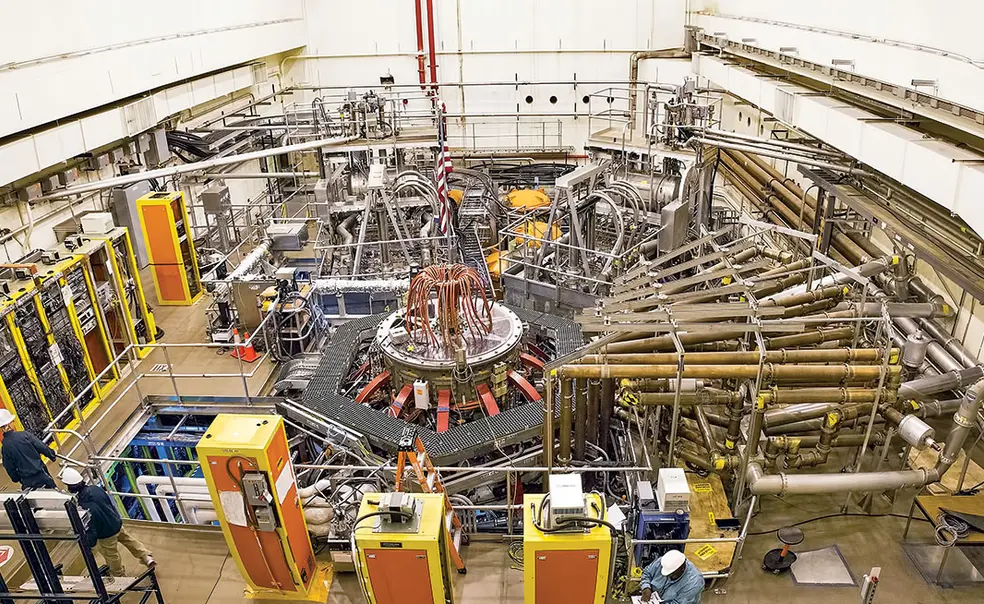A Star on Earth
With a $94 million upgrade, PPPL reactor could play key role in fusion-plant design
Fusion reactors are shaping up — as spheres, rather than doughnuts.
For decades, researchers have tried to harness fusion power with tokamaks, doughnut-shaped magnetic cages that keep hydrogen nuclei hot enough to merge and release energy. But now, a fusion reactor at the Princeton Plasma Physics Laboratory (PPPL) called the National Spherical Torus Experiment-Upgrade (NSTX-U) could help show that something a bit more ball-like could be more compact and efficient, and therefore less costly to build.
“Compact is good,” said PPPL director Stewart Prager. “Generally, you think that smaller costs less.” The experiment began regular operations in December after a $94 million upgrade, and, for the forseeable future, it will command the attention of two-thirds of PPPL’s overall budget and staff. “It could be the scientific anchor for the laboratory looking a decade into the future,” Prager said.
Fusion is a seductive notion: a nearly limitless, carbon-free source of energy. It doesn’t create long-lived radioactive waste like nuclear fission, nor is there a risk of runaway reactions. One of its fuels can be found in ocean water. But you essentially have to stoke up a star on Earth. At the temperatures required for fusion — about 150 million degrees C — atomic nuclei seethe in a turbulent, ionized gas, or plasma, that would vaporize anything it touches.
However, the plasma is charged, which means it can be tamed by the forces of a magnetic field. In the late 1950s, Soviet scientists developed tokamaks to trap and circulate the plasma (the name comes from a Russian acronym for “toroidal chamber with magnetic coils”).
But as they have grown in size, traditional tokamaks have bogged down in expense and complexity. The world’s largest fusion reactor, an international project called ITER being built in France, is supposed to demonstrate net energy gain for the first time — more energy created by fusion than is injected to heat and contain the plasma. ITER was launched in 2006 with a price tag of $5.6 billion and a goal of first plasma in 2016. But first plasmas now are not expected until 2025, and costs have soared past $17 billion.
Some researchers say trading the doughnut for something more like a cored apple could be just what the doctor ordered. In the 1980s, Department of Energy (DOE) scientists in Tennessee built the first spherical reactors — still technically tokamaks, but with a tall and narrow central core. They realized that tightly wound magnetic field lines around the central core would keep plasma particles from spiraling out, bleeding away heat and damaging reactor walls. Plasma particles “spend more time on average in a region of the magnetic field where the stability is better,” said Jon Menard, NSTX-U program director. The main drawback for spherical tokamaks is one of limited legroom: Magnets and other equipment must be stuffed within the narrow core.
Building on the initial ideas from the 1980s, the original NSTX began operations in 1999. With the upgrade, it is now the world’s most powerful test of the spherical approach. ITER’s chamber encloses 80 times more plasma than NSTX-U, so PPPL’s machine won’t be coming close to providing a net energy gain. But it nonetheless could influence the design of future devices. “If our results are positive, it could say that a spherical tokamak would be an attractive candidate design for a fusion pilot plant,” Prager said.
The upgrade, which got a green light from the DOE in 2011, has two main components. First is a set of new copper magnets that loop around the sphere and connect in a thicker core. Overall, the magnetic field strength will double to 1 Tesla — 20,000 times the strength of Earth’s magnetic field. Steel struts and supports were added so the machine could resist the extra torques, said Ron Strykowski, who recently retired after overseeing construction of the upgrade.
The other major component of the upgrade was the installation of a second injection beam, which will allow for hotter, longer fusion pulses. The 85-ton beam line, refurbished from a shuttered PPPL experiment, injects hydrogen fuel into the plasma chamber, heats it up, and helps to circulate the plasma. PPPL scientists will aim for 120 fusion “shots” per week, each lasting as much as 5 seconds — five times longer than before. “It’s like a brand-new machine,” Menard said.
NSTX-U is not the only experiment grappling with the future shape of fusion. A rival spherical tokamak in the United Kingdom, called the Mega Amp Spherical Tokamak, is getting its own upgrade, and is due to fire up in 2017. And in December, researchers in Germany switched on the Wendelstein 7-X, a fiendishly twisted take on the tokamak called a stellarator. PPPL was building its own stellarator until the DOE pulled the plug in 2008.
Fusion scientists don’t know yet which shape will rise to the top when it comes time to build ITER’s successor. “We don’t have enough information to know what that looks like,” said Dennis Whyte, director of MIT’s Plasma Science and Fusion Center. The bizarre twists of the stellarator could win out, or it could be an amalgam of NSTX-U and ITER: an apple-doughnut. The performance of NSTX-U will be a key input, Whyte said. “They’re moving into uncharted territory,” he said. “We need NSTX-U to help us optimize.”












No responses yet